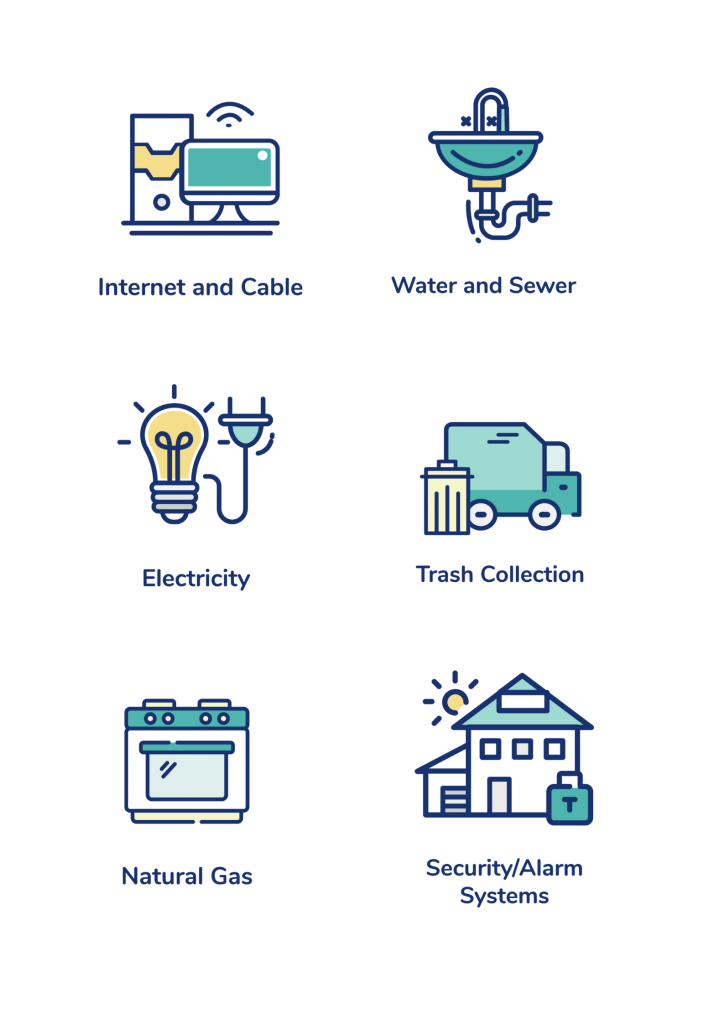
There are several things on your mind as you’re getting ready to move. Utilities are one of the most important things to set up. You’ll need electricity, gas, water, internet, among other utilities. Our goal is to make renting easier for you, especially when you’re moving. We’ll show you how to set up all of your utilities in less time.
Which Utilities Do You Need to Set Up?
Your lease will tell you which utilities you are responsible for. You can also ask your landlord. Usually, landlords will cover certain utilities, like water and trash.
Below is a complete list of utilities you may need to set up:

You should ask your landlord if there are preferred providers. For example, your unit may be wired to receive a cable from a certain provider, like Comcast or Dish. It’s best to double-check with your landlord before reaching out to providers. And for electricity, there is typically only one provider. By asking your landlord which provider to contact, you remove some of the guesswork and save time.
Two crucial questions to ask your landlord about utilities before moving in:
1. Which utilities do you need to set up?
2. Are there preferred providers for each utility?
Next, we’ll dive deeper into each utility and?explain what each utility does, how much time you’ll need to set up service, and how much it may cost.?
Electricity
Electricity is a form of energy drawn from electric generators. Anything you plug into your outlets is powered by electricity. For example, your lighting, appliances, and air conditioning are likely powered by electricity.
Depending on where you live, there will be different electricity providers. You can look up electric companies based on your location here.
Below, we’ve listed some of the largest electricity providers across the nation:
Pacific Gas & Electric Consolidated Edison and Commonwealth Edison (ComEd)DTE EnergyPublic Service Electricity & GasConsumers Energy
Electricity providers can typically start and stop service with one-day notice. We still recommend setting up utilities ahead of time just in case, but you can usually turn on service within one day.
If you move to a deregulated energy state, you can choose your electricity supplier the same way you choose your supplier for the internet, cable or mobile phone. The process is digital, instant, and free. In addition to finding the cheapest electric rate, you can get a plan with the sustainable renewable electricity and “go green” with a push of a button.
With most utilities, the cost will vary based on how much you use it. To reduce the cost of electricity (and conserve energy), make sure to turn off lights when you’re not home, or in rooms that you’re not currently using. The average tenant spends about $30-50?on electricity per month. This number will vary based on how much energy you use and how many people live in the unit.?
Natural Gas
Natural gas is a fossil fuel used as a source of energy. In rental properties, natural gas is used for heating and cooking. If you have a gas stove, then you’re relying on natural gas for cooking. Some units may have an electrical heater, which would be powered by electricity. However, it’s more common for heating to be powered by gas. Similarly, hot water heaters are often heated with gas.
Here’s a complete list of natural gas providers across the U.S. You can look up which providers are available in your state.
It typically takes one week for natural gas providers to process your request to start or stop service. As a result, you’ll want to transfer service at least one week ahead of time.
Just as with deregulated electricity, if you move to a deregulated natural gas state, you can choose your natural gas supplier, get the cheapest gas rate and switch to a renewable gas plan. If you’re only relying on gas for cooking, you could expect your bill to be roughly $10-20.
If you’re also relying on gas for heat, then your utility bill for natural gas will be higher and will fluctuate based on the season. It will be more expensive if you’re heating a larger space, a space with high ceilings, or a space located in a cold climate. Given all of these variables, the cost of natural gas varies greatly, but the average cost will be between $10-120 per month.
Internet, Cable, and Telephone
You can typically purchase these utilities altogether. Here’s a list of the largest internet, cable, and telephone providers in the United States:
ComcastTime Warner CableDish NetworkCharter CommunicationsRCN
Cable and internet may take longer to set up because you may need to get additional equipment. For wifi internet access, the utility company will give you a router. For cable, you’ll likely need a cable box.?If you already have your equipment, you can take it with you to your next apartment. If not, the process may require waiting for the equipment to arrive in the mail or setting up a time for a technician to install it.
If you set up your plan about two weeks before moving in, you should be all set on moving day. Comcast tells its customers, “If you let us know in advance of your move, we can help make it as seamless as possible. We will make every effort to eliminate any time without service.”
Internet costs will depend on what speed you are purchasing. High-speed internet will be slightly more expensive. The cost of cable will depend on what kind of a cable package you purchase. If you only buy basic cable then it will be less expensive than purchasing additional channels. Similarly, it’ll be more expensive if you are purchasing the capability to record television (Tivo or DVR) and if you are receiving access to On Demand.
One way to save money on this utility is to reach out to neighbors in an effort to coordinate internet use — note that this will only work if you live in a multi-unit building. You can also save money by not purchasing a telephone line. Nowadays, most people prefer to solely use their cell phones.
Security Systems
Security systems can include an alarm system, security cameras, and even air quality updates so you will be notified if there’s carbon monoxide or smoke. Alarms are great for added security, because whether you’re home or away, the alarm will notify you if someone opens your door or window.
Here are three of the largest security system providers in the United States:
ADTStanley CSSProtection One
Providers like Canary provide an alarm, cameras, and air quality measure for a very reasonable price. An added benefit is you can easily take your canary security system with you when you move out of your rental. A service like Canary will cost about $300-400 to purchase the product and then $9.99 per month moving forward. Installing a built-in alarm system can cost about $600 dollars, but the downside is you can’t take it with you when you leave.
Keep in mind that you can typically get a discount on your renters insurance if you have a security system in place. So not only will you have a safer home, but you’ll also reduce your cost of insurance.
When to Set Up Utilities
It’s important to set up utilities before you move, ideally about two weeks before you move. You’ll need utilities working from the first day you live there. When you’re setting up utilities, you’ll select a start date. If you’re moving in on the first of the month, then the utility start date is the first of the month.
Some landlords will set up Landlord Rollover for important utilities so that when one tenant moves out, the utilities switch temporarily to the landlord’s name. This ensures that services stay on between tenants; pipes won’t freeze, the power stays on, and water will still be delivered.
That said, it’s best to plan ahead to have utilities start on the day you move. But if for some reason you don’t, then landlord rollover may offer you some flexibility.
How to Set Up Utilities
If you already have utilities set up for your current apartment and you’re moving within the same city, you can transfer?service from one address to another. If you don’t, all major companies make it simple to become a new customer.
To set up utilities, we recommend going to the provider’s webpage and logging in or signing up. Most providers have online portals that make it easy and fast to transfer, start, or stop service.
Here’s what you’ll need to provide:
New address (make sure to include your unit number)Start date or transfer date
You can call each company separately if you want to, but it’s typically much faster to complete these requests online.
Helpful Moving Tips for Renters
Setting up or transferring utilities is a standard part of moving, and won’t take too long. Just make sure you communicate with your landlord to find out if there are any preferred providers and give yourself enough time to set up or transfer the utilities before you move in.
Once you’ve got utilities squared away, consider these helpful moving tips:
Do you need renters insurance? Find out if renters insurance is worth it and what it will (and won’t) cover.Read our tips for splitting the rent with roommates and keeping everyone happy.Find out how to boost your credit score just by paying rent.






0